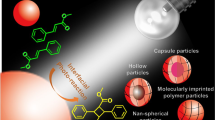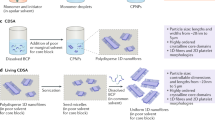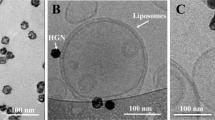Abstract
Gold nanovesicles contain multiple nanocrystals within a polymeric coating. The strong plasmonic coupling between adjacent nanoparticles in their vesicular shell makes ultrasensitive biosensing and bioimaging possible. In our laboratory, multifunctional plasmonic vesicles are assembled from amphiphilic gold nanocrystals (such as gold nanoparticles and gold nanorods) coated with mixed hydrophilic and hydrophobic polymer brushes or amphiphilic diblock co-polymer brushes. To fulfill the different requirements of biomedical applications, different polymers that are either pH=responsive, photoactive or biodegradable can be used to form the hydrophobic brush, while the hydrophilicity is maintained by polyethylene glycol (PEG). This protocol covers the preparation, surface functionalization and self-assembly of amphiphilic gold nanocrystals grafted covalently with polymer brushes. The protocol can be completed within 2 d. The preparation of amphiphilic gold nanocrystals, coated with amphiphilic diblock polymer brushes using a 'grafting to' method or mixed hydrophilic and hydrophobic polymer brushes using tandem 'grafting to' and 'grafting from' methods, is described. We also provide detailed procedures for the preparation and characterization of pH-responsive plasmonic gold nanovesicles from amphiphilic gold nanocrystals using a film-rehydration method that can be completed within ∼3 d.
This is a preview of subscription content, access via your institution
Access options
Subscribe to this journal
Receive 12 print issues and online access
$259.00 per year
only $21.58 per issue
Buy this article
- Purchase on Springer Link
- Instant access to full article PDF
Prices may be subject to local taxes which are calculated during checkout








Similar content being viewed by others
References
Graham, D., Thompson, D.G., Smith, W.E. & Faulds, K. Control of enhanced Raman scattering using a DNA-based assembly process of dye-coded nanoparticles. Nat. Nanotechnol. 3, 548–551 (2008).
Halas, N.J. Plasmonics: an emerging field fostered by nano letters. Nano Lett. 10, 3816–3822 (2010).
Halas, N.J., Lal, S., Chang, W.-S., Link, S. & Nordlander, P. Plasmons in strongly coupled metallic nanostructures. Chem. Rev. 111, 3913–3961 (2011).
Hutter, E. & Fendler, J.H. Exploitation of localized surface plasmon resonance. Adv. Mater. 16, 1685–1706 (2004).
Skrabalak, S.E., Au, L., Li, X. & Xia, Y. Facile synthesis of Ag nanocubes and Au nanocages. Nat. Protoc. 2, 2182–2190 (2007).
Cheng, L., Liu, A.P., Peng, S. & Duan, H.W. Responsive plasmonic assemblies of amphiphilic nanocrystals at oil-water interfaces. ACS Nano 4, 6098–6104 (2010).
Giljohann, D.A. et al. Gold nanoparticles for biology and medicine. Angew. Chem. Int. Ed. Engl. 49, 3280–3294 (2010).
Lim, D.-K. et al. Highly uniform and reproducible surface-enhanced Raman scattering from DNA-tailorable nanoparticles with 1-nm interior gap. Nat. Nanotechnol. 6, 452–460 (2011).
Morton, S.M., Silverstein, D.W. & Jensen, L. Theoretical studies of plasmonics using electronic structure methods. Chem. Rev. 111, 3962–3994 (2011).
Rosi, N.L. & Mirkin, C.A. Nanostructures in biodiagnostics. Chem. Rev. 105, 1547–1562 (2005).
Klinkova, A., Choueiri, R.M. & Kumacheva, E. Self-assembled plasmonic nanostructures. Chem. Soc. Rev. 43, 3976–3991 (2014).
Kneipp, J., Kneipp, H. & Kneipp, K. SERS-a single-molecule and nanoscale tool for bioanalytics. Chem. Soc. Rev. 37, 1052–1060 (2008).
Cheng, L., Song, J., Yin, J. & Duan, H. Self-assembled plasmonic dimers of amphiphilic gold nanocrystals. J. Phys. Chem. Lett. 2258–2262 (2011).
He, J. et al. Self-assembly of amphiphilic plasmonic micelle-like nanoparticles in selective solvents. J. Am. Chem. Soc. 135, 7974–7984 (2013).
Xu, L. et al. Regiospecific plasmonic assemblies for in situ Raman spectroscopy in live cells. J. Am. Chem. Soc. 134, 1699–1709 (2011).
Sun, C. et al. Controlling assembly of paired gold clusters within apoferritin nanoreactor for in vivo kidney targeting and biomedical imaging. J. Am. Chem. Soc. 133, 8617–8624 (2011).
Kim, N.H., Lee, S.J. & Moskovits, M. Reversible tuning of SERS hot spots with aptamers. Adv. Mater. 23, 4152–4156 (2011).
Murthy, V.S., Cha, J.N., Stucky, G.D. & Wong, M.S. Charge-driven flocculation of poly(L-lysine)gold nanoparticle assemblies leading to hollow microspheres. J. Am. Chem. Soc. 126, 5292–5299 (2004).
Pornpattananangkul, D. et al. Bacterial toxin-triggered drug release from gold nanoparticle-stabilized liposomes for the treatment of bacterial infection. J. Am. Chem. Soc. 133, 4132–4139 (2011).
Rasch, M.R. et al. Hydrophobic gold nanoparticle self-assembly with phosphatidylcholine lipid: membrane-loaded and janus vesicles. Nano Lett. 10, 3733–3739 (2010).
Maye, M.M., Chun, S.C., Han, L., Rabinovich, D. & Zhong, C.-J. Novel spherical assembly of gold nanoparticles mediated by a tetradentate thioether. J. Am. Chem. Soc. 124, 4958–4959 (2002).
Han, X., Liu, Y. & Yin, Y. Colorimetric stress memory sensor based on disassembly of gold nanoparticle chains. Nano Lett. 14, 2466–2470 (2014).
Al-Jamal, W.T. & Kostarelos, K. Liposomes: from a clinically established drug delivery system to a nanoparticle platform for theranostic nanomedicine. Acc. Chem. Res. 44, 1094–1104 (2011).
Discher, D.E. & Eisenberg, A. Polymer vesicles. Science 297, 967–973 (2002).
Tanner, P. et al. Polymeric vesicles: from drug carriers to nanoreactors and artificial organelles. Acc. Chem. Res. 44, 1039–1049 (2011).
Discher, B.M., Hammer, D.A., Bates, F.S. & Discher, D.E. Polymer vesicles in various media. Curr. Opin. Chem. Biol. 5, 125–131 (2000).
Zhuang, J., Gordon, M.R., Ventura, J., Li, L. & Thayumanavan, S. Multi-stimuli responsive macromolecules and their assemblies. Chem. Soc. Rev. 42, 7421–7435 (2013).
Vigderman, L., Khanal, B.P. & Zubarev, E.R. Functional gold nanorods: synthesis, self-assembly, and sensing applications. Adv. Mater. 24, 4811–4841 (2012).
Shenhar, R., Norsten, T.B. & Rotello, V.M. Polymer-mediated nanoparticle assembly: structural control and applications. Adv. Mater. 17, 657–669 (2005).
Tang, Z. & Kotov, N.A. One-dimensional assemblies of nanoparticles: preparation, properties, and promise. Adv. Mater. 17, 951–962 (2005).
Amstad, E., Kim, S.-H. & Weitz, D.A. Photo- and thermoresponsive polymersomes for triggered release. Angew. Chem. Int. Ed. Engl. 124, 12667–12671 (2012).
Li, Y., Smith, A.E., Lokitz, B.S. & McCormick, C.L. In situ formation of gold-'decorated' vesicles from a RAFT-synthesized, thermally responsive block copolymer. Macromolecules 40, 8524–8526 (2007).
Song, J. et al. Plasmonic vesicles of amphiphilic gold nanocrystals: self-assembly and external-stimuli-triggered destruction. J. Am. Chem. Soc. 133, 10760–10763 (2011).
Song, J. et al. Photolabile plasmonic vesicles assembled from amphiphilic gold nanoparticles for remote-controlled traceable drug delivery. Nanoscale 5, 5816–5824 (2013).
Song, J., Pu, L., Zhou, J., Duan, B. & Duan, H. Biodegradable theranostic plasmonic vesicles of amphiphilic gold nanorods. ACS Nano 7, 9947–9960 (2013).
Song, J., Zhou, J. & Duan, H. Self-assembled plasmonic vesicles of SERS-encoded amphiphilic gold nanoparticles for cancer cell targeting and traceable intracellular drug delivery. J. Am. Chem. Soc. 134, 13458–13469 (2012).
Lin, J. et al. Photosensitizer-loaded gold vesicles with strong plasmonic coupling effect for imaging-guided photothermal/photodynamic therapy. ACS Nano 7, 5320–5329 (2013).
Huang, P. et al. Biodegradable gold nanovesicles with an ultrastrong plasmonic coupling effect for photoacoustic imaging and photothermal therapy. Angew. Chem. Int. Ed. Engl. 52, 13958–13964 (2013).
Nederberg, F., Connor, E.F., Moller, M., Glauser, T. & Hedrick, J.L. New paradigms for organic catalysts: the first organocatalytic living polymerization. Angew. Chem. Int. Ed. Engl. 40, 2712–2715 (2001).
Wang, Y., Xu, H. & Zhang, X. Tuning the amphiphilicity of building blocks: controlled self-assembly and disassembly for functional supramolecular materials. Adv. Mater. 21, 2849–2864 (2009).
Kang, Y. & Taton, T.A. Controlling shell thickness in core–shell gold nanoparticles via surface-templated adsorption of block copolymer surfactants. Macromolecules 38, 6115–6121 (2005).
He, J., Liu, Y., Babu, T., Wei, Z. & Nie, Z. Self-assembly of inorganic nanoparticle vesicles and tubules driven by tethered linear block copolymers. J. Am. Chem. Soc. 134, 11342–11345 (2012).
Sinha Ray, S. Polylactide-based bionanocomposites: a promising class of hybrid materials. Acc. Chem. Res. 45, 1710–1720 (2012).
Jouault, N., Lee, D., Zhao, D. & Kumar, S.K. Block-copolymer-mediated nanoparticle dispersion and assembly in polymer nanocomposites. Adv. Mater. 26, 4031–4036 (2014).
Zubarev, E.R., Xu, J., Sayyad, A. & Gibson, J.D. Amphiphilic gold nanoparticles with V-shaped arms. J. Am. Chem. Soc. 128, 4958–4959 (2006).
Nikoobakht, B. & El-Sayed, M.A. Preparation and growth mechanism of gold nanorods (NRs) using seed-mediated growth method. Chem. Mater. 15, 1957–1962 (2003).
Kang, Y. & Taton, T. Core/shell gold nanoparticles by self-assembly and crosslinking of micellar, block-copolymer shells. Angew. Chem. Int. Ed. Engl. 44, 409–412 (2005).
Acknowledgements
This work was supported by the intramural research program (IRP) of the National Institute of Biomedical Imaging and Bioengineering (NIBIB), the US National Institutes of Health (NIH) and the National Science Foundation of China (grant 81401465 to P. Huang).
Author information
Authors and Affiliations
Contributions
J.S. and X.C. conceived and designed the research; J.S. performed the experiments and contributed new reagents and analytical tools; J.S. and P.H. analyzed the data; and J.S. and X.C. wrote the manuscript.
Corresponding author
Ethics declarations
Competing interests
The authors declare no competing financial interests.
Rights and permissions
About this article
Cite this article
Song, J., Huang, P. & Chen, X. Preparation of plasmonic vesicles from amphiphilic gold nanocrystals grafted with polymer brushes. Nat Protoc 11, 2287–2299 (2016). https://doi.org/10.1038/nprot.2016.137
Published:
Issue Date:
DOI: https://doi.org/10.1038/nprot.2016.137
This article is cited by
-
Self-assembly of polysarcosine amphiphilic polymers-tethered gold nanoparticles for precise photo-controlled synergistic therapy
Nano Research (2023)
-
Plasmonic anisotropic gold nanorods: Preparation and biomedical applications
Nano Research (2022)
-
Tunable catalytic activity of gold nanoparticle decorated SBA-15/PDMAEMA hybrid system
Journal of Porous Materials (2020)
-
Strong and stiff Ag nanowire-chitosan composite films reinforced by Ag–S covalent bonds
Nano Research (2018)
Comments
By submitting a comment you agree to abide by our Terms and Community Guidelines. If you find something abusive or that does not comply with our terms or guidelines please flag it as inappropriate.



